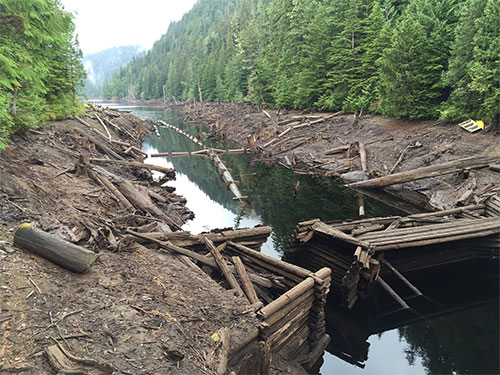Low water exposes the banks of a reservoir near Ketchikan during the drought. |
No exact amount of low precipitation triggers a drought; instead, it results when drier-than-normal conditions last long enough to affect the local environment and people. Impacts can become more severe when soil and vegetation dry out from a combination of low precipitation, warm temperatures, wind and sunshine.
High evaporation in summer 2019 was one factor that contributed to an “extreme drought” declaration by the U.S. Drought Monitor, a tracking system operated by federal agencies and university research partners. Southeast Alaska had never before reached that drought intensity.
Scientists at the University of Alaska Fairbanks and the National Oceanic and Atmospheric Administration are studying this drought, its causes and impacts, and the likelihood of future similar droughts. The Southeast Alaska Drought Project is a partnership between Rick Thoman, at UAF’s Alaska Center for Climate Assessment and Policy, Heather McFarland at UAF’s International Arctic Research Center, Andrew Hoell at NOAA’s Physical Sciences Laboratory and Britt Parker at NOAA’s National Integrated Drought Information System.
The team found that an unusual lack of storms contributed to the Southeast Alaska drought. Storms typically originate over the Aleutian Islands, traveling along a reliable track that brings moist air to Southeast Alaska, especially in winter. During the drought years from 2016 to 2019, that pattern changed. Storms were “blocked” from the region by unusually high pressure over the Aleutian Islands. In the absence of those storms, Southeast Alaska experienced extended periods of dry and sunny weather.
Though Southeast Alaska has seen dry spells in the past, including a short drought in 2004 and a longer one in the 1990s, the 2016-2019 drought followed a decade of much wetter conditions. This made the drought particularly jarring to those experiencing it. Low reservoir levels triggered water restrictions and a shift from hydroelectric to diesel-generated power in communities across the region.
Humans weren’t the only ones who struggled to adapt to the drought. Southeast’s rainforest is well adapted to persistently wet conditions, and many local plants and animals don’t respond well to dryness. During the drought, residents reported low berry production, the Tongass National Forest saw almost twice as many wildfires, and insects damaged over half a million acres of rainforest.
While the 2016-2019 drought is still a recent memory, it’s important to know whether this kind of event will happen again in the future. Thoman and Hoell used climate models to show that by 2050 Southeast Alaska is likely to get slightly wetter and a lot warmer. They also found that the chance of a drought like the 2016-2019 occurring again is declining, but drought is still possible in a rainforest even in a warming and wetting world.
Learn more about the Southeast Alaska Drought Project through a series of two-pagers on drought history, causes, impacts and future.
Note: This project was funded by the NOAA National Integrated Drought Information System with additional support from the UAF Alaska Center for Climate Assessment and Policy, NOAA Award NA16OAR4310162.
Heather McFarland is Communications Lead at the International Arctic Research Center. She translates complex scientific information about the Arctic, climate change and wildlife populations into visual and written stories that people connect with and understand. She has experience in science writing, graphic design, science graphics, social media, communicating to diverse audiences and community outreach. Heather’s background is in Arctic biology and conservation. Contact Heather McFarland at hrmcfarland@alaska.edu |
Representations of fact and opinions in comments posted are solely those of the individual posters and do not represent the opinions of Sitnews.
Send a letter to the editor@sitnews.us
SitNews ©2022
Stories In The News
Ketchikan, Alaska
Articles & photographs that appear in SitNews are considered protected by copyright and may not be reprinted without written permission from and payment of any required fees to the proper freelance writers and subscription services.
E-mail your news & photos to editor@sitnews.us
Photographers choosing to submit photographs for publication to SitNews are in doing so granting their permission for publication and for archiving. SitNews does not sell photographs. All requests for purchasing a photograph will be emailed to the photographer.

